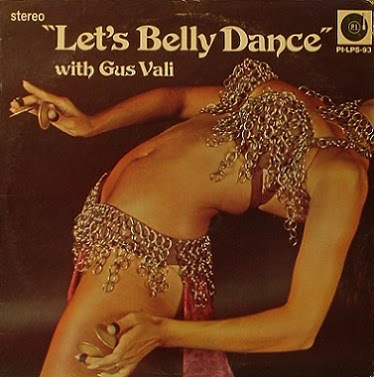For those of you who dug the compelling music on the somewhat ridiculously titled 'Belly Dance Navel Academy', I present you with another LP by Greek-American flautist-clarinetist-bandleader Gus Vali.
Let's Belly Dance is the follow-up album on the no-frills Peters International label and pretty much picks up where its predecessor left off. As with other belly dance records from the 1970s, the mood here is a little funkier than similar releases from the 1950s and 1960s what with the more up-to-date instrumentation. Whatever might be lost in regard to authenticity is more than made up for in terms of groove.
According to the liner notes, Gus Vali's parents were ethnic Greeks from western Turkey, no doubt accounting for his fluency in modes of musical expression from that part of the world. The list of personnel on this recording is quite impressive and includes several veterans from New York City's Middle Eastern nightclub scene of the preceding decades. Many, in fact, were onetime associates of John Berberian. Egyptian-born kanunist Mohammed El Akkad performed with the oudist early in his career, but never recorded with him.
Clarinetist extraordinaire Souren Baronian (a mainstay on John's earlier albums) sets aside his woodwind instrument on this session in favor of the finger cymbals, while the redoubtable duo of bassist Chet Amsterdam and drummer Bill LaVorgna, who both played on the extraordinary Middle Eastern Rock, serve as the rhythm section. George Mgrdichian, who many consider to be at least Berberian's equal, plays the oud on Let's Belly Dance, and the violinist listed as Haskel Obadia is most likely Iraqi native Hakki Obadia, who also released a number of albums under his own name. Rounding things out are Ali Hafid on dumbeg and Joseph Castellon on, as the liners put it, "utility percussion." Sorta like a utility infielder on a baseball team, perhaps?
Like Belly Dance Navel Academy, this LP consists entirely of instrumentals, and most of the tracks seem to be Arabic in origin, judging by their titles. The propulsive opening cut "Fasulya" gets straight to the heart of the matter and showcases Mgrdichian's complete mastery of the oud, as does "Ya Jamalik", "Ya Raitni Ma Hawitez," and "Ya Reim Wadi Thaqif". Obadia's swooping violin solos are the difficult-to-choose highlights of "Samia", "El Gazalle" and "Al Jazayer". Pieces both mellow - "Pharonic Dance" and "Whyek" - as well as dynamic - "Tokat" and "Andolou" - give Vali the opportunity to display his substantial chops on flute and clarinet.
Throughout these aforementioned performances, Amsterdam's slinky bass lines prove to be nothing short of jaw-dropping, and one could persuasively argue that he is the most impressive instrumentalist on these proceedings. "Caravan #9" and "Caravan #5" are brief rhythmic exercises that signify the conclusion of each side of the album in its original vinyl format. The track that inspires the greatest amount of curiosity on my part is "The Wounded Animal" which I believe is another rendition of a like-titled performance that also appeared on the outstanding Rosko-John Berberian spoken word-Middle Eastern music collaboration Music and Gibran.
In short, further proof that albums with alluring photos of the female form can sometimes contain excellent music.
Tracklist:
A1. FasulyaA2. Samia
A3. Pharonic Dance
A4. Tokat
A5. Ya Jamalik
A6. The Speechless Animal
A7. Caravan #9
B1. Andolou
B2. El Gazalle
B3. Ya Raitni Ma Hawitez
B4. Whyek
B5. Al Jazayer
B6. Ya Reim Wadi Thaqif
B7. Caravan #5
